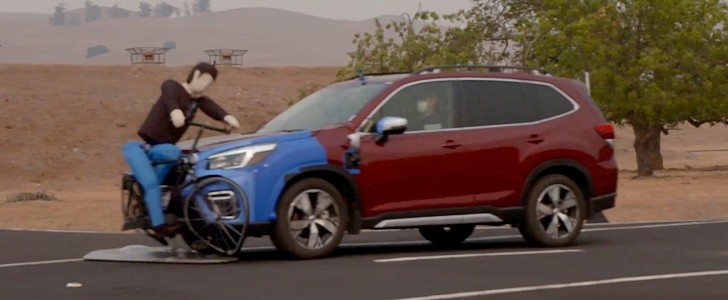Advanced driver assistance systems (ADAS) have become the norm for many vehicles today and some of them are even mandatory to get certain certifications and accolades, like the IIHS’ Top Safety Pick+. But a new study from AAA shows the systems behave unexpectedly in some of the most dangerous situations, making things worse instead of keeping the drivers safe.
Most new vehicles today come with at least an automatic emergency braking system to help drivers in certain situations. Many carmakers tout automated driving as the next best thing and employ various degrees of automated driving systems in their most advanced models. They are supposed to offer drivers some relief or at least help them in dangerous moments, but an AAA test showed they can do neither.
To understand how these systems evolve, AAA periodically tests various vehicles from different brands. Recently, they concluded their third round of tests using a 2021 Subaru Forester, a 2020 Tesla Model 3, and a 2021 Hyundai Santa Fe, all with Level 2 semi-autonomous driving features. The scope of the tests was to find out how these systems perform when encountering a slow vehicle in their lane (a car or a bicycle) versus how they react when an incoming vehicle drifted into their lane.
The first round of tests showed promising results, with all tested cars being able to slow down and avoid the slow-moving vehicle in front of them. On the other hand, none of them was capable of avoiding a head-on collision with an incoming vehicle drifting into their lane, and this was consistent throughout all 15 runs. The closed-course tests also showed that the automated driving systems failed to avoid a crash with a crossing bicycle in five out of 15 runs, or 33% of the time.
“While it may be encouraging that these driving systems successfully spotted slow-moving cars and bicyclists in the same lane, the failure to spot a crossing bike rider or an oncoming vehicle is alarming,” said Greg Brannon, director of AAA’s automotive engineering. “A head-on crash is the deadliest kind, and these systems should be optimized for the situations where they can help the most.”
The fact that these driver assistance systems appear to do their job and then stub you in the back in the most dangerous situation contributes to people not trusting the technology. According to AAA, 85% of people surveyed are fearful or unsure of self-driving technology, a level that has remained steady for the past several years. When transporting their children or loved ones, 85% also said they would not be comfortable with using a self-driving vehicle.
The AAA findings show the importance of drivers staying alert and remaining continuously engaged in the driving task. Putting too much trust in an automated driving system can be deadly, and many crashes prove this. Several associations including AAA advocate for direct driver monitoring systems with camera-based technology to be integrated into active driving assistance systems. This is needed to avoid distracted driving when the person behind the wheel cedes too much control to the car’s systems.
To understand how these systems evolve, AAA periodically tests various vehicles from different brands. Recently, they concluded their third round of tests using a 2021 Subaru Forester, a 2020 Tesla Model 3, and a 2021 Hyundai Santa Fe, all with Level 2 semi-autonomous driving features. The scope of the tests was to find out how these systems perform when encountering a slow vehicle in their lane (a car or a bicycle) versus how they react when an incoming vehicle drifted into their lane.
The first round of tests showed promising results, with all tested cars being able to slow down and avoid the slow-moving vehicle in front of them. On the other hand, none of them was capable of avoiding a head-on collision with an incoming vehicle drifting into their lane, and this was consistent throughout all 15 runs. The closed-course tests also showed that the automated driving systems failed to avoid a crash with a crossing bicycle in five out of 15 runs, or 33% of the time.
“While it may be encouraging that these driving systems successfully spotted slow-moving cars and bicyclists in the same lane, the failure to spot a crossing bike rider or an oncoming vehicle is alarming,” said Greg Brannon, director of AAA’s automotive engineering. “A head-on crash is the deadliest kind, and these systems should be optimized for the situations where they can help the most.”
The fact that these driver assistance systems appear to do their job and then stub you in the back in the most dangerous situation contributes to people not trusting the technology. According to AAA, 85% of people surveyed are fearful or unsure of self-driving technology, a level that has remained steady for the past several years. When transporting their children or loved ones, 85% also said they would not be comfortable with using a self-driving vehicle.
The AAA findings show the importance of drivers staying alert and remaining continuously engaged in the driving task. Putting too much trust in an automated driving system can be deadly, and many crashes prove this. Several associations including AAA advocate for direct driver monitoring systems with camera-based technology to be integrated into active driving assistance systems. This is needed to avoid distracted driving when the person behind the wheel cedes too much control to the car’s systems.






